
The 7th century is the period from 601 through 700 in accordance with the Julian calendar in the Christian Era.

The 8th century is the period from 701 through 800 (DCCC) in accordance with the Julian Calendar.
The 640s decade ran from January 1, 640, to December 31, 649.

Year 683 (DCLXXXIII) was a common year starting on Thursday of the Julian calendar. The denomination 683 for this year has been used since the early medieval period, when the Anno Domini calendar era became the prevalent method in Europe for naming years.
Year 640 (DCXL) was a leap year starting on Saturday of the Julian calendar. The denomination 640 for this year has been used since the early medieval period, when the Anno Domini calendar era became the prevalent method in Europe for naming years.

A pagoda is a tiered tower with multiple eaves common to Thailand, Cambodia, Nepal, China, Japan, Korea, Myanmar, Vietnam, and other parts of Asia. Most pagodas were built to have a religious function, most often Buddhist, but sometimes Taoist, and were often located in or near viharas. The pagoda traces its origins to the stupa, while its design was developed in ancient India. Chinese pagodas are a traditional part of Chinese architecture. In addition to religious use, since ancient times Chinese pagodas have been praised for the spectacular views they offer, and many classical poems attest to the joy of scaling pagodas.

Chinese architecture is the embodiment of an architectural style that has developed over millennia in China and has influenced architecture throughout East Asia. Since its emergence during the early ancient era, the structural principles of its architecture have remained largely unchanged. The main changes involved diverse decorative details. Starting with the Tang dynasty, Chinese architecture has had a major influence on the architectural styles of neighbouring East Asian countries such as Japan, Korea, Vietnam, and Mongolia in addition to minor influences on the architecture of Southeast and South Asia including the countries of Malaysia, Singapore, Indonesia, Sri Lanka, Thailand, Laos, Cambodia and the Philippines.

The Small Wild Goose Pagoda, sometimes Little Wild Goose Pagoda, is one of two significant pagodas in Xi'an, Shaanxi, China, the site of the old Han and Tang capital Chang'an. The other notable pagoda is the Giant Wild Goose Pagoda, originally built in 652 and restored in 704. This pagoda, along with the Giant Wild Goose Pagoda and other sites along the Silk Road, was inscribed in 2014 on the UNESCO World Heritage List as the Silk Roads: the Routes Network of Chang'an-Tianshan Corridor World Heritage Site.
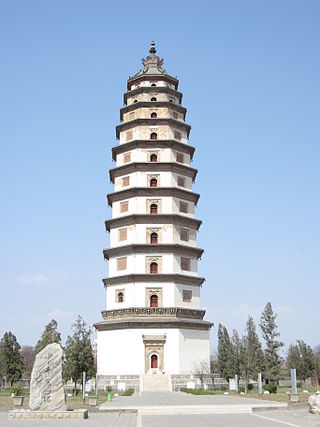
The Liaodi Pagoda of Kaiyuan Monastery, Dingzhou, Hebei Province, China is the tallest existing pre-modern Chinese pagoda and tallest brick pagoda in the world, built in the 11th century during the Song dynasty (960–1279). The pagoda stands at a height of 84 meters (276 ft), resting on a large platform with an octagonal base. Upon completion in 1055, the Liaodi Pagoda surpassed the height of China's previously tallest pagoda still standing, the central pagoda of the Three Pagodas, which stands at 69.13 m (230 ft). The tallest pagoda in pre-modern Chinese history was a 100-meter (330 ft)-tall wooden pagoda tower in Chang'an built in 611 by Emperor Yang of Sui, yet this structure no longer stands. It is considered one of the Four Treasures of Hebei.
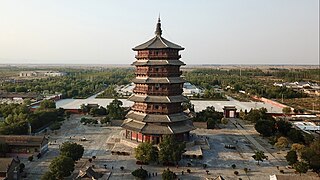
The Sakyamuni Pagoda of Fogong Temple of Ying County, Shanxi province, China, is a wooden Chinese pagoda. It is also known as the Wooden Pagoda of Ying County. It was constructed in 1056, during the second year of the Khitan-led Liao dynasty and was renovated and expended in 1195 during the sixth year of the Jin Dynasty. The pagoda was built by Emperor Daozong of Liao (Hongji) at the site of his grandmother's family home. The pagoda, which has survived several large earthquakes throughout the centuries, reached a level of such fame within China that it was given the generic nickname of the "Muta".

Qixia Temple is a Buddhist temple located on Qixia Mountain in the suburban Qixia District of Nanjing, Jiangsu, 22 kilometres (14 mi) northeast of downtown Nanjing. It is one of Nanjing's most important Buddhist monasteries. The temple is the cradle of East Asian Mādhyamaka.

Hōryū-ji is a Buddhist temple that was once one of the powerful Seven Great Temples, in Ikaruga, Nara Prefecture, Japan. Its full name is Hōryū Gakumonji (法隆学問寺), or Learning Temple of the Flourishing Law, the complex serving as both a seminary and monastery.
Pagodas in Japan are called tō, sometimes buttō or tōba, and derive historically from the Chinese pagoda, itself an interpretation of the Indian stupa. Like the stupa, pagodas were originally used as reliquaries, but in many cases ended up losing this function. Pagodas are quintessentially Buddhist and an important component of Japanese Buddhist temple compounds but, because until the Kami and Buddhas Separation Act of 1868, a Shinto shrine was normally also a Buddhist temple and vice versa, they are not rare at shrines either. The famous Itsukushima Shrine, for example, has one. After the Meiji Restoration the word tō, once used exclusively in a religious context, came to mean also "tower" in the western sense, as for example in Eiffel Tower.

Kaiyuan Temple is a Buddhist temple located in West Street, Quanzhou, China, and is considered as the largest Buddhist temple in Fujian province with an area of 78,000 square metres (840,000 sq ft). The central figures of veneration in the temple are the Five Tathāgathas from Chinese Esoteric Buddhism who are enshrined in the temple's Mahavira Hall. In 2021, the temple was inscribed on the UNESCO World Heritage List along with other sites near Quanzhou because of its importance during the medieval global maritime trade based in Quanzhou and its testimony to the global exchange of ideas and cultures. The temple is also one of few in China to contain Hindu monuments, left there by traders from Southern India.
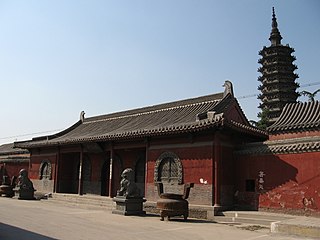
Linji Temple is a Buddhist temple located in Zhengding Town of Zhengding County, Hebei, China. In the mid-Tang dynasty (618–907), Linji Yixuan founded the Linji school, which eventually became one of the five major schools of Buddhism in China. In the Song dynasty (960–1276), two Japanese monks Eisai and Shuniyo introduced Linji school to Japan. Linji Temple is the cradle of Linji (Rinzai) school of both Chinese and Japanese Buddhism. The temple was added to National Key Buddhist Temples in Han Chinese Area's list in 1983. The eldest thing in the temple is the Chengling Stupa, which still preserves the architectural style of the Liao and Jin dynasties (916–1234).

The Shrine of Living Buddha is a Buddhist temple located at the Divine Light Summit (神光岭) of Mount Jiuhua, in Qingyang County, Anhui, China.

Daci'en Temple is a Buddhist temple located in Yanta District, Xi'an, Shaanxi. The temple is the cradle of East Asian Yogācāra in China. It is notable for the Giant Wild Goose Pagoda. The pagoda was originally built by the monk Xuanzang, whose pilgrimage to India inspired the novel Journey to the West. Alongside Daxingshan Temple and Jianfu Temple, it was one of the three sutras translation sites (三大译经场) in the Tang dynasty.

Xiangji Temple is a Buddhist temple located in Chang'an District of Xi'an, Shaanxi. The temple is regarded as the cradle of Pure Land Buddhism.
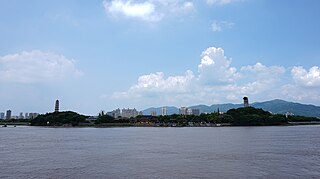
Jiangxin Temple is a Buddhist temple located on Jiangxin Island, in Lucheng District of Wenzhou, Zhejiang, China.
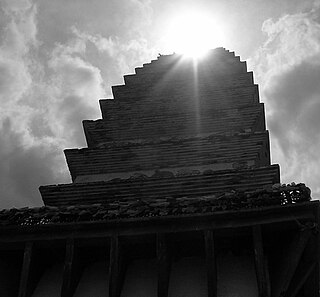
Tongwadian, also known as Jinding Temple, is a Buddhist temple located on Mount Jizu, in Dali Prefecture, Yunnan, China.



















